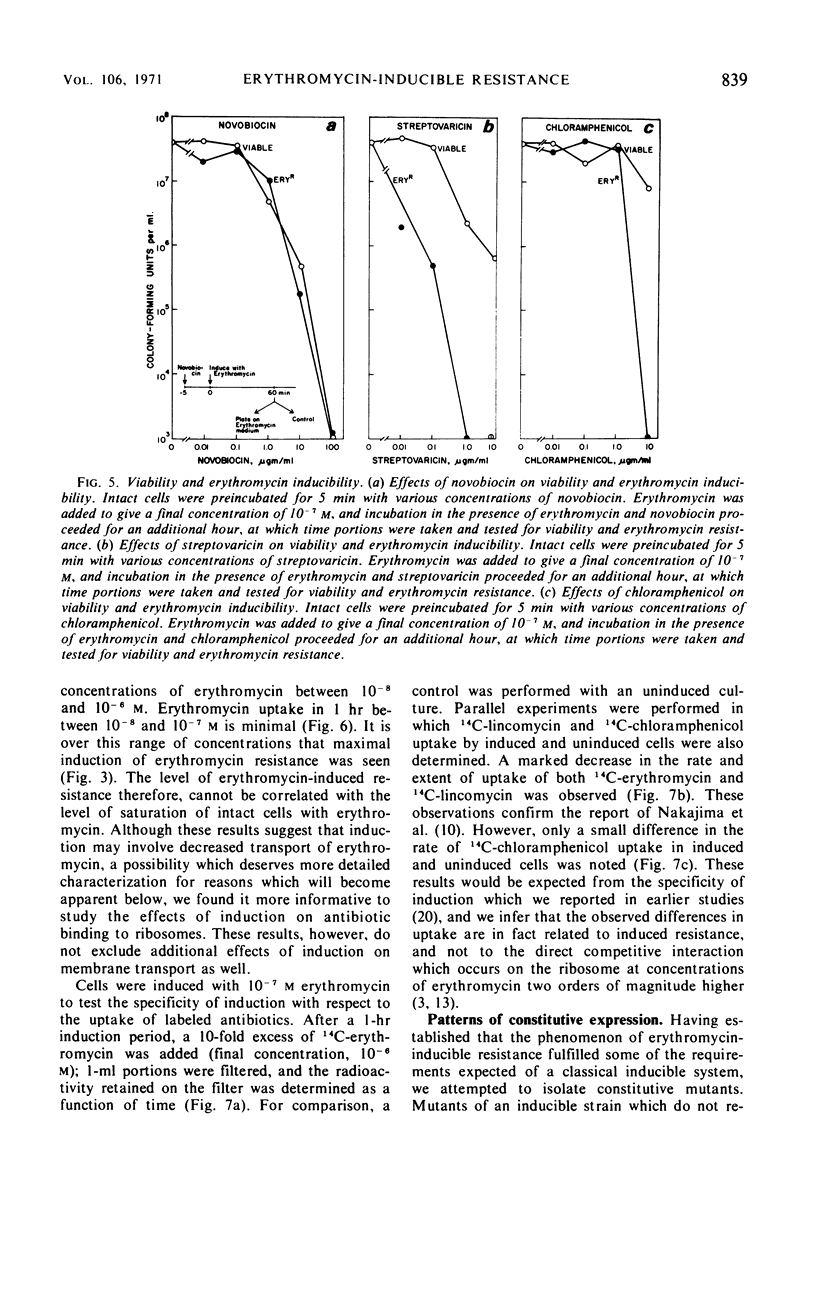Abstract
At least two functionally different types of ribosomes are found in strains of Staphylococcus aureus which display “dissociated” resistance to erythromycin. One type of ribosome is found under conditions of growth in ordinary nutrient broth, and the second is formed during growth in the presence of erythromycin. In these strains, erythromycin acts as an inducer of resistance to three different classes of inhibitors of the 50S ribosomal subunit—the macrolides, lincosamides, and streptogramin B-type antibiotics. The optimal inducing concentration of erythromycin is between 10−8 and 10−7m. Concentrations as low as 10−9m can produce a 10-fold increase in resistant cells over the uninduced, background level, whereas concentrations greater than 10−7m block induction owing to inhibition of protein synthesis. Resistant cells begin to appear within 5 to 10 min after addition of erythromycin (to 10−7m), and within 40 min (i.e., about one generation) more than 90% of the entire culture is resistant to erythromycin as well as to lincomycin and vernamycin Bα. A resistant culture becomes sensitive if grown for 90 min in the absence of erythromycin. The process of induction is inhibited by chloramphenicol and streptovaricin, which inhibit protein and ribonucleic acid synthesis, respectively, but not by novobiocin, which inhibits deoxyribonucleic acid synthesis. Resistant cells produced in this manner fail to concentrate 14C-erythromycin and 14C-lincomycin, but not 14C-chloramphenicol. Constitutively erythromycin-resistant strains which do not require the presence of erythromycin for expression of resistance can be selected on media containing antibiotics which belong to any one of the three classes. Two patterns of constitutive resistance have been found. These are (i) generalized constitutive resistance—which involves resistance in the absence of erythromycin to all members of each of the three cited classes of 50S subunit inhibitors which were tested, and (ii) partial constitutive resistance—which involves different degrees of resistance, in the absence of erythromycin, to various members of the three classes. Several different patterns of variable constitutivity are possible. 50S ribosomal subunits isolated from induced or constitutively resistant cells show decreased ability to bind erythromycin and lincomycin, and possible enzymatic inactivation of these antibiotics has been rigorously excluded. The induced change, therefore involves modification of ribosome structure rather than modification of the antibiotic.
Full text
PDF












Images in this article
Selected References
These references are in PubMed. This may not be the complete list of references from this article.
- CHABBERT Y. Antagonisme in vitro entre l'érythromycine et la spiramycine. Ann Inst Pasteur (Paris) 1956 Jun;90(6):787–790. [PubMed] [Google Scholar]
- Chang F. N., Siddhikol C., Weisblum B. Subunit localization studies of antibiotic inhibitors of protein synthesis. Biochim Biophys Acta. 1969 Aug 20;186(2):396–398. doi: 10.1016/0005-2787(69)90020-3. [DOI] [PubMed] [Google Scholar]
- Chang F. N., Weisblum B. The specificity of lincomycin binding to ribosomes. Biochemistry. 1967 Mar;6(3):836–843. doi: 10.1021/bi00855a025. [DOI] [PubMed] [Google Scholar]
- Hashimoto H., Oshima H., Mitsuhashi S. Drug resistance of staphylococci. IX. Inducible resistance to macrolide antibiotics in Staphylococcus aureus. Jpn J Microbiol. 1968 Sep;12(3):321–327. [PubMed] [Google Scholar]
- Kono M., Hashimoto H., Mitsuhashi S. Drug resistance to staphylococci. 3. Resistance to some macrolide antibiotics and inducible system. Jpn J Microbiol. 1966 Apr;10(1):59–66. [PubMed] [Google Scholar]
- Lai C. J., Weisblum B. Altered methylation of ribosomal RNA in an erythromycin-resistant strain of Staphylococcus aureus. Proc Natl Acad Sci U S A. 1971 Apr;68(4):856–860. doi: 10.1073/pnas.68.4.856. [DOI] [PMC free article] [PubMed] [Google Scholar]
- Mizuno S., Yamazaki H., Nitta K., Umezawa H. Inhibition of DNA-dependent RNA polymerase reaction of Escherichia coli by an antimicrobial antibiotic, streptovaricin. Biochim Biophys Acta. 1968 Apr 22;157(2):322–332. doi: 10.1016/0005-2787(68)90086-5. [DOI] [PubMed] [Google Scholar]
- Nakajima Y., Inoue M., Oka Y., Yamagishi S. A mode of resistance to macrolide antibiotics in Staphylococcus aureus. Jpn J Microbiol. 1968 Jun;12(2):248–250. doi: 10.1111/j.1348-0421.1968.tb00390.x. [DOI] [PubMed] [Google Scholar]
- Novick R. P. Penicillinase plasmids of Staphylococcus aureus. Fed Proc. 1967 Jan-Feb;26(1):29–38. [PubMed] [Google Scholar]
- Saito T., Hashimoto H., Mitsuhashi S. Drug resistance of staphylococci. Foation of erythromycin-ribosome complex. Decrease in the formation of erythromycin-ribosome complex in erythromycin resistant strains of Staphylococcus aureus. Jpn J Microbiol. 1969 Mar;13(1):119–121. doi: 10.1111/j.1348-0421.1969.tb00441.x. [DOI] [PubMed] [Google Scholar]
- Siddhikol C., Erbstoeszer J. W., Weisblum B. Mode of action of streptolydigin. J Bacteriol. 1969 Jul;99(1):151–155. doi: 10.1128/jb.99.1.151-155.1969. [DOI] [PMC free article] [PubMed] [Google Scholar]
- Smith D. H., Davis B. D. Mode of action of novobiocin in Escherichia coli. J Bacteriol. 1967 Jan;93(1):71–79. doi: 10.1128/jb.93.1.71-79.1967. [DOI] [PMC free article] [PubMed] [Google Scholar]
- Vazquez D. Binding of chloramphenicol to ribosomes. The effect of a number of antibiotics. Biochim Biophys Acta. 1966 Feb 21;114(2):277–288. doi: 10.1016/0005-2787(66)90309-1. [DOI] [PubMed] [Google Scholar]
- Vazquez D. Binding to ribosomes and inhibitory effect on protein synthesis of the spiramycin antibiotics. Life Sci. 1967 Apr 15;6(8):845–853. doi: 10.1016/0024-3205(67)90287-1. [DOI] [PubMed] [Google Scholar]
- WEAVER J. R., PATTEE P. A. INDUCIBLE RESISTANCE TO ERYTHROMYCIN IN STAPHYLOCOCCUS AUREUS. J Bacteriol. 1964 Sep;88:574–580. doi: 10.1128/jb.88.3.574-580.1964. [DOI] [PMC free article] [PubMed] [Google Scholar]
- Weisblum B., Demohn V. Erythromycin-inducible resistance in Staphylococcus aureus: survey of antibiotic classes involved. J Bacteriol. 1969 May;98(2):447–452. doi: 10.1128/jb.98.2.447-452.1969. [DOI] [PMC free article] [PubMed] [Google Scholar]





